The Beast from 20 000 Fathoms (1953)
Directed by: Eugène Lourié
Written by: Eugène Lourié, Fred Freiberger, Lou Morheim, Ray Bradbury, Robert Smith
Starring: Cecil Kellaway, Paul Christian, Paula Raymond
USA
AVAILABLE ON BLU-RAY, DVD and DIGITAL
RUNNING TIME: 80 mins
REVIEWED BY: Dr Lenera
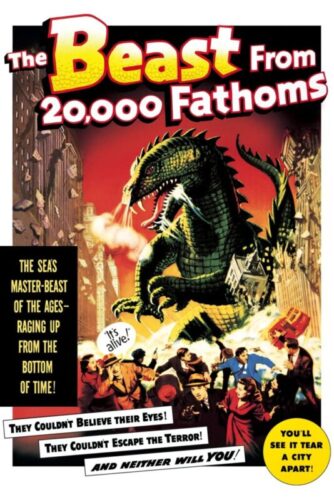
Far north of the Arctic Circle, a nuclear bomb test is conducted which awakens a 200-foot long carnivorous dinosaur known as a Rhedosaurus, thawing it out of the ice where it had been held in suspended animation for millions of years. Physicist Thomas Nesbitt is the only surviving witness to the beast’s awakening and is dismissed out-of-hand as being delirious at the time. Despite the skepticism, he persists, knowing what he saw. As the creature begins making its way down the east coast of North America causing chaos and destruction, Nesbitt eventually gains allies in paleontologist Thurgood Elson and his young assistant Lee Hunter after a fisherman identifies from a collection of drawings the very same dinosaur that Nesbitt saw. Elson proposes that the dinosaur is returning to the Hudson River area, where fossils of Rhedosaurus were first found…..
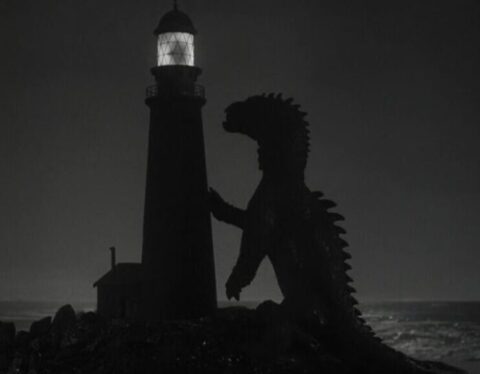
Former production designer Eugene Lourie’s fame rests largely on the fact that he directed three movies about dinosaurs wrecking havoc in modern times; The Beast From 20 000 Fathoms, The Giant Behemoth and Gorgo. Watch each one and you’re find out that they’re almost the same movie, with not just plot ideas and themes but even scenes rehashed. I decided that it would be fun to watch and review all three. This first is undeniably the most important, and not just because it was where stop motion legend Ray Harryhausen was first let loose on his own. No, it’s also because it was the very first creature feature of the 1950’s, and set down most of the cliches that would be repeated over and over again. The hero with a story nobody will believe, the kindly scientist with the pretty assistant for the hero to fall in love with, discussions with terrified witnesses, initial monster attacks in isolated locales before an attack on a major city, etc – it’s all here. There’s a strong case to be made for the following year’s giant ant picture Them! doing some of this stuff better, but nonetheless The Beast From 20 000 Fathoms deserves a lot more respect for starting it all off, as well as inspiring Godzilla. Think about it; if there hadn’t have been a Beast, there wouldn’t have been a Godzilla! Oddly enough the lousy 1998 American version of Godzilla was far more a remake of The Beast From 20 000 Fathoms, write down to some direct copying of scenes, though writer Dean Devlin and director Roland Emmerich never admitted this as far as I know. I’d have probably liked their film a bit more if they had. This 1953 movie is a simple, straight down the line monster movie which sometimes seems a bit rough around the edges, but then it was a fairly low budget production, so what was achieved is quite impressive. Harryhausen’s genius is already in full flow, there’s no comic relief and very little romantic stuff to slow down the pace, and no less than Lee Van Cleef kills the monster!
The project was prompted by a very successful [though cut] re-release of King Kong, and was initially called The Monster From Under The Sea, the script by Lourie being about scientists releasing a monster from the Earth’s core to be killed by a giant robot; it was rather too ambitious for a low budget outfit like General Service Studios. A second draft entitled The Monster From Beneath The Sea, employing the services of Fred Freiberger, Louis Morheim and Robert Smith was much closer to what they would have been able to achieve. Co-producer Jack Dietz was unsure how to visualise his monster, Harryhausen found out about the project and offered to do the special effects, also rewriting bits of the script. While visiting his friend Harryhausen on the set, master science-fiction writer Ray Bradbury was given a copy of the script and asked if he could do some rewriting on it. After reading it, he remarked about a scene in the story being very similar to a short story that he’d published in The Saturday Evening Post several years earlier called The Beast From 20,000 Fathoms in which a dinosaur destroyed a lighthouse. The next day he received a telegram offering to buy the film rights to the story. After the sale, the film’s title was changed. When Bradbury’s story was reprinted years later, he retitled if to The Fog Horn. Early pre-production conceptual sketches of the Beast showed that, at one point, it was to have a shelled head and then a beak. There were even plans to have the Beast snort flames, but this idea was dropped before production began due to budget restrictions; the concept, however, was used for the film poster. Dietz and co-producer Hal Chester became worried about the film’s commercial prospects and sold it to Warner Bros, who commissioned a new music score from David Buttolph because the first one by Michel Michelet wasn’t deemed dramatic enough. The film was a huge success.
The titles come out of swirling water to be followed by underwater footage behind the letters; most of it is obviously stock footage which is something the viewer had best get used to because there’s a hell of a lot of it in the film, especially in its first ten minutes set in the North Pole where a base with an exercise employing planes had to be realised. Much of it sticks out because it’s scratchy, as does the placing of characters against already shot backgrounds, but a lot of films did this at the time to save costs [the same year’s bigger budgeted War Of The Worlds did it], and this production was a really tight one. Narration setting the scene such as we have here was fairly common too. “Professor Tom Nesbitt and Colonel Jack Evans, military leaders, are waiting”. “The timing is perfect so far”. “Every man knows his job, he does it quickly, silently”. It’s a bit chucklesome, but the explosion edits together avalanche and explosive footage, some of it from She, quite well and the snowy studio backdrops are actually rather good. “Colonel Evans, there’s something strange on the radar screen” says someone, but then it’s gone. “Every time one of these things goes off I feel as if I’m helping to create the first chapter of a new Genesis” says somebody; honestly, he says this. Of course the only appropriate answer is “Let’s hope we don’t find ourselves writing the last chapter of the old one”. Nesbitt is out there with another guy who sees the monster. Yes, no endless waiting around for the true star of the film here, he’s seen clearly right here. The other guy falls into a ravine and breaks his leg but is able to fire his gun to alert Nesbitt, who then sees it himself before another landslide occurs. Revived inside the base, all he can cry is “It’s coming! Watch out! The Monster! The Monster!”, an idea given a more chilling variation in Them! with that little girl saying “Them”!
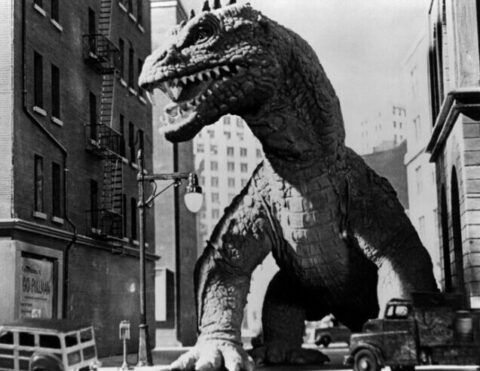
Nesbitt just isn’t believed. Upon seeing the newspaper headline SEA SERPENT REPORTED OFF GRAND BANKS he leaves psychiatric care to track down paleontologist Thurgood Elson; he doesn’t believe him either but his pretty secretary Lee Hunter seems more open minded, or is that just because she fancies him? She tells Elson that she “Used to attend his lectures on the creative properties of the radioactive isotope”, which at least sets thing up for the finale. A second ship is destroyed, and we see it, though on the radio someone snarkily says “You really ought to stop smoking that stuff and try Virginia Gold“. Elson identifies the creature from lots of dinosaur pictures in a scene which goes on far too long, then tries to hunt down the two survivors of the two boating disasters. One had disappeared but one is convinced to tell Elson what he saw. There’s an emphasis on the idea of people not being believed; it adds some urgency. The dinosaur is called a Rhedosaurus, a fictitious creature who was the forerunner of the Brontosaurus. A skeleton of one is in a room by Elson’s office; it’s actually the one in Bringing Up Baby. Elson is now on board, and of course thinks the Beast should be captured alive than be destroyed. He insists in going to see it in a diving bell, which is pretty daft if you ask me, but Elson’s excitement, wonderfully portrayed by Cecil Kellaway, is rather lovely. Of course he pays for such foolishness, though we don’t see any of this in a subtly handled scene. The Beast is clearly headed for the New York area where he used to live, and we oddly don’t see any evacuation take place. Evans leads the defense which employs guns, an electrified barricade, then bazookas which do succeed in wounding it and driving it back into the sea, but unfortunately, it bleeds all over the streets, unleashing a horrible contagion, which begins to infect the populace, causing even more fatalities. This idea could have been developed more, but the infection does preclude blowing up the Rhedosaurus or even setting it ablaze. What will they do?
The Beast, parts of which would be used to make the dragon in The 7th Voyage Of Sinbad, looks a tad lost as it rampages about, probably wondering why his old neighbourhood has changed so much. He takes a while to crush a car and does it virtually by accident. He might swallow a policeman whole in a scene trimmed in some early release versions, but he’s gotta eat, right? Throughout, the Beast is shot from unusual angles, but one portion of the New York attack looks down upon the Beast as he’s bathed in floodlights. Harryhausen chose to mostly combine shots of places with the Beast in the foreground rather then have models built, though the terrific shot of the Beast coming out of the sea at the harbour adds model work too. An early assault on a ship suffers from a still background plate in one long shot, but the famous destruction of the lighthouse is done simply and effectively in silhouette with one facial closeup, the Beast’s face a bit distorted as seen through a window. The most convincing effects shots have the Beast wrecking the Coney Island theme park, as if the most time and money was allotted to them; one combines roller coaster background footage with a miniature of said rollercoaster being destroyed by the Beast while the actors are close by. His death, which is lingered upon, provides the right level of empathy with this living being that was rudely awakened in a brave new world. The Beast only destroying a few buildings and the full Army not going into action might disappoint some viewers used to full-on kaiju mayhem, but the money wasn’t there for that, and Lourie is able to create a surprising strong, almost documentary-like atmosphere some of the time instead, with silliness mostly absent. His experience as a production designer meant that he was able to minimise costs for the few sets that there are.
The love story is reduced to Nesbitt saying to Lee “I’ll phone you even if nothing happens,” the two of them at the ballet being interrupted, and a kiss. That’s just the way we like it. A love triangle would soon be employed a great deal in such films, including the next Harryhausen project which commenced his lengthy partnership with Charles H. Schneer, It Came From Beneath The Sea, often resulting in tedium. Here, it’s all about proving the Beast exists, then trying to stop it. Paul Christian is a likeable hero with a tad more personality than usual. When Kellaway as Elson is speaking to Kenneth Tobey as Evans on the phone, he asks if he’s sure there are no flying saucers; was this a reference to the Tobey-starring The Thing From Another World? Buttolph’s music score isn’t really memorable but is quite restrained for the time, being not particularly busy with notes, emphasising slow, low chords over melody. The only slightly lyrical music plays after Elson’s death. The Beast From 20 000 Fathoms isn’t quite a classic if taken on its own; it’s extremely narrow in characterisation [the Beast is the most interesting character] and some of the dialogue is pretty lousy. Yet its historical importance is very strong and ought to be recognised by more. And t’s a very solid creature feature with some considerable technical care and expertise being employed.
.Rating: 











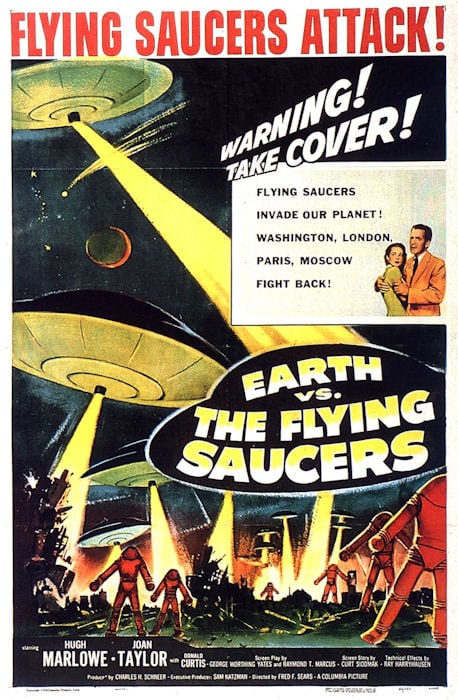

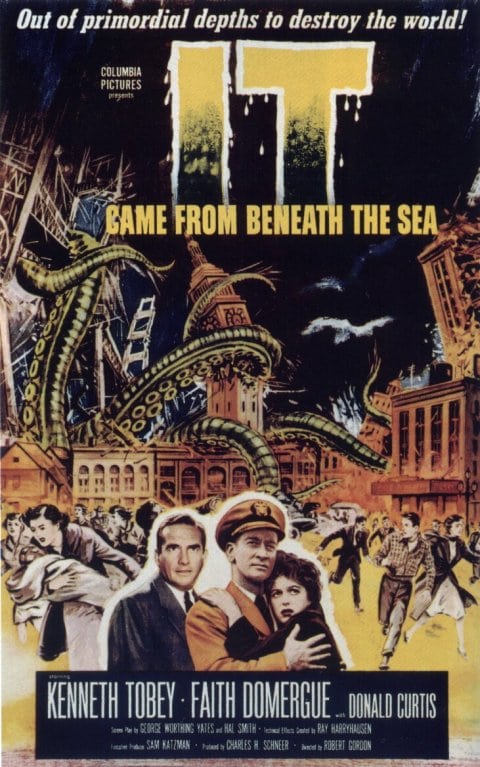
Be the first to comment